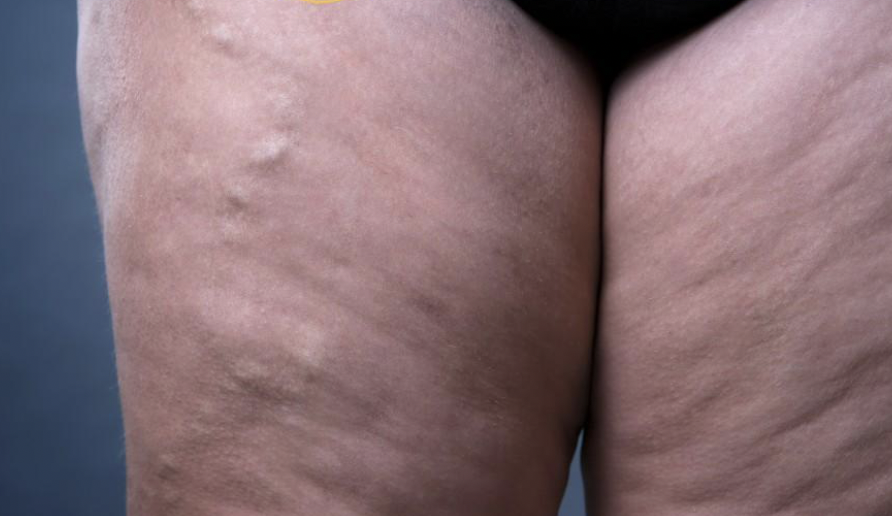Medically reviewed by Dr. Anuj Kr Purbey.
The Lipedema pinch test is a phrase that is mentioned frequently by women in the Lipedema community, especially on the Lipedema forums. But what is the Lipedema pinch test and what does it involve? Is it a viable method to help recognise the signs of Lipedema? Keep reading to find out more.
Firstly, what is Lipedema?
It is a progressive condition, meaning Lipedema gets worse over time, causing an abnormal accumulation of fat cells, primarily affecting the legs, hips, bum and sometimes the arms. How Lipedema differs from obesity is very important – Lipedema fat is often resistant to diet and exercise and causes characteristic Lipedema pain and swelling. The affected areas can become tender and bruise easily due to the increased fragility of the blood vessels.
Lipedema predominantly occurs in women and is believed to have a genetic component. Getting a proper Lipedema diagnosis and management are crucial to slow down how quickly Lipedema progresses, which can lead to mobility issues and further complications. Treatment options include massage for Lipedema, known as manual lymphatic drainage, wearing compression garments, and in some cases, liposuction.
What is the pinch test for Lipedema?
The Lipedema pinch test is a straightforward self-examination technique that can help identify even stage 1 Lipedema symptoms and early signs to look out for. The test involves gently pinching the skin and underlying tissue in the affected area, typically the thighs or lower legs, to assess the texture and pain response of the tissue.
How to do the pinch test
- Choose the Right Spot: Select an area where Lipedema is commonly found, such as the thighs or lower legs.
- Pinch the Skin: Gently pinch the skin and underlying tissue.
- Assess the Response: Pay attention to the texture and pain. With Lipedema, the pinched area may feel tender and have a different texture compared to non-affected areas. The tissue may feel nodular, like small beans in a bean bag, which is one of the distinctive visual characteristics of Lipedema.
What is a positive pinch test?
The Lipedema pinch test can provide initial insights into whether you might have Lipedema. A positive response – painful, nodular tissue – suggests the need for further evaluation. However, this test is not definitive and should be followed up with a professional diagnosis from a qualified Lipedema specialist near you.
Limitations of the pinch test for Lipedema
While useful, the pinch test has its limitations:
- Not Conclusive: The test alone cannot diagnose Lipedema definitively. Overlapping symptoms with conditions like Lymphedema and obesity can lead to confusion.
- Professional Evaluation Needed: Additional diagnostic tools such as a thorough medical history check and physical examination by a Lipedema professional are essential for an accurate diagnosis and treatment plan.
Next steps after a positive pinch test
If the pinch test suggests Lipedema, the next step is to consult with a Lipedema specialist. Early diagnosis and intervention are crucial for effective management. A Lipedema specialist can highlight the key differences between Lipedema and Lymphedema or venous insufficiency, and recommend whether conservative or surgical treatments for Lipedema are right for you.
So, how do I self test for Lipedema?
The Lipedema pinch test is a helpful first step in identifying potential Lipedema, but should not be relied upon as the sole diagnostic method. Always follow up with a professional evaluation to confirm the diagnosis and explore effective Lipedema treatments you can do at home.
By providing a detailed, practical guide on performing and interpreting the Lipedema pinch test, this blog post aims to give women the knowledge they need to take proactive steps towards managing their health and wellbeing.
For additional information on diagnosing and managing Lipedema, you can refer to resources from Lipoedema UK, the Lipedema Foundation and Lipedema.net. We have also created a Lipedema Quiz that can be used alongside the pinch test to try and determine whether it’s time to chase an official Lipedema diagnosis.
Disclaimer: This article has been medically reviewed by Dr. Anuj Kr Purbey to ensure accuracy. However, it is provided for informational purposes only and should not replace in-person medical advice. Always consult your doctor or a qualified specialist for diagnosis and treatment.



Hey, I really appreciate your website, it’s super helpful expecially as there aren’t many resources on lipedema out there. I am leaving a comment to ask about further resources that could be helpful to have here aswell. A lot of us on reddit (including myself) have concerns about skin texture, and in my experience it’s really hard to find online resources about what is normal vs what texture is indicative of lipedema. I really appreciate your ‘pinch test’ section of the blog but I find that it doesn’t quite answer my questions. I (and many others I’ve seen online) have a strange beady/nodular texture appear when I squeeze an area on my calves, upper ankles or thighs. I saw that in the ‘pinch test’ section you mentioned that the feeling of nodules is a symptom but my fat feels smooth mostly, in some areas like the outer thigh it’s rougher and bumpy, but it doesn’t really feel like pebbles in most areas. To summarise, I’m suggesting that it would be helpful to have the reasons for this beady texture be addressed on the blog along with images as so many of us have questions and concerns about it. Additionally, I would like to say that while I really appreciate the website providing a ‘lipedema quiz’, I think this feature is super helpful, I also think that changes could be made to it, for example the quiz focuses mainly on response to weight loss and disproportion but not everyone has attempted weight loss since noticing symptoms or may be too ealry stage to notice disproportion. I think that the quix should also take into account leg texture (like I mentioned previously), pressure marks/sock marks/skin imprints (this is a symptom I see discussed a lot on tiktok and I myself experience), ‘cellulite’ on the calves, and skin thickness. These are symptoms that to my knowledge do not occur in individuals without lipedema, and I think addressing them would be much appreciated by many of us who stumble across this blog looking for answers to these less-discussed symptoms. I hope I don’t come across as being too critical, whilst I have many suggestions I also think this website is truly amazing and I’m glad such a website exists as there are way too few resources on lipedema.
Thank you for your time
& All the best,
Ingrid